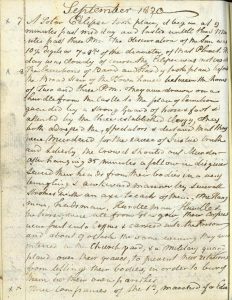Today, we commemorate the brave sacrifice made by John Baird and Andrew Hardie, who stood up for the rights of the common man 200 years ago.
Baird and Hardie were executed on the 8th September at Stirling, a crowd of 2,000 people were in attendance. Brave to the last, both men gave short speeches on the scaffold, Baird ended his speech “Although this day we die an ignominious death by unjust laws our blood, which in a very few minutes shall flow on this scaffold, will cry to heaven for vengeance, and may it be the means of our afflicted Countrymen’s speedy redemption.” Hardie then spoke of “our blood, shed on this scaffold… for no other sin but seeking the legitimate rights of our ill-used and down trodden beloved Countrymen”, then when the Sheriff angrily intervened he concluded by asking those present to “go quietly home and read your Bibles, and remember the fate of Hardie and Baird.”
The Council Archives holds two volumes of the diary of Dr Thomas Lucas, surgeon of Stirling that cover the period 1808 – 1821 . Lucas recorded many of the events that happened in and around Stirling in his diary, and attended the execution of Baird and Hardie on the 8th September. His diary entry for that day provides us with an eye-witness account that can be read alongside those given in the local and national press.
Diary entry of Dr Thomas Lucas, Surgeon Stirling, 8th September 1820
“The Executions of Baird and Hardy took place before the Broad Stair of the Town House between the hours of Two and three pm. They were drawn on a Hurdle from the Castle to the place of Execution guarded by a strong Guard of horse and foot and attended by the three established Clergy. They both addressed the Spectators and declared that they were Murdered for the cause of Justice truth and Liberty. The Crowd shouted out Murder. After hanging 35 minutes a fellow in disguise severed their heads from their bodies in a very bungling and awkward manner by severall strokes with an axe to each of them. The Hangman, headsman, Hurdleman, Hurdle and the horse were all from Glasgow. Their Corpses were put into Coffins and carried into the Prison and about 9 o’clock the same evening they were interred in the Churchyard, and a Military guard placed over their graves, to prevent their relations from lifting their bodies, in order to bury them in their own parishes.”
For comparison, here is an article from the Courier newspaper of 12th September 1820
A much longer piece appeared in the Stirling Journal of 12th September and this can be accessed at the Council Archives by anyone interested as it is too long to reproduce here.
The robe worn by the decapitator, along with the axe used are currently held at The Smith Museum and Art Gallery in Stirling.
Baird and Hardie were granted a Royal pardon in 1835. Their remains were disinterred and transferred to Sighthill Cemetery in Glasgow in 1847, where a monument to them and their comrades in the uprising was erected in that year.


